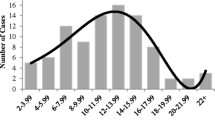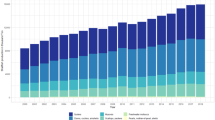Abstract
Background, Aim and Scope
As Life Cycle Assessment is being increasingly applied to study fisheries and aquaculture systems, the LCA methodology must be adapted to address the unique aspects of these systems. The focus of this methodological paper is the specific allocation problems faced in studying seafood production systems and how they have been addressed to date.
Main Features
The paper begins with a literature review of existing LCA research of fishing and aquaculture systems with a specific focus on 1) identifying the key allocation problems; 2) describing the choice of allocation procedures; and 3) providing insight on the rationale for those choices where available. The allocation procedures are then discussed in the context of ISO recommendations and other published guidance on allocation, followed by a discussion of the key lessons to be learned from the reviewed studies and recommendations for future LCAs of seafood production systems.
Literature Review
The literature review suggests that allocation problems are most likely to arise when dealing with: landed by-catch within the context of capture fisheries, the use of co-product feed ingredients in aquaculture feeds, multiple outputs from fish farms, and the generation of by-products when seafood is processed. System expansion and allocation according to physical causality were not applied in most cases, while economic allocation was the most widely used approach. It was also observed that the level of detail and justification provided for allocation decisions in most published reports was inconsistent and incomplete.
Discussion
The results of this literature review are consistent with other reviews of allocation in LCA in that allocation according to economic value was found to be the most frequently applied approach. The application of economic allocation when system expansion is not feasible is consistent with ISO guidance. However, economic allocation is not the most appropriate method in seafood production LCAs because it does not reflect the biophysical flows of material and energy between the inputs and outputs of the production system.
Conclusions, Recommendations and Perspectives
More effort needs to be invested in developing allocation procedures appropriate to seafood production systems. Allocation based on gross energy content is proposed as one potential alternative means of allocating environmental burdens in some instances in seafood production LCAs. A standard set of requirements for how to describe and justify allocation decisions in published reports is needed to make these studies more robust and transparent.
Similar content being viewed by others
References
Weidema BP (2001): Avoiding Co-Product Allocation in Life-Cycle Assessment. Journal of Ind Ecol 4(3) 11–33
Ekvall T, Finnveden G (2001): Allocation in ISO 14041 — A critical review. Journal of Cleaner Production 9, 197–208
Guinee J, Gorree M, Heijungs R, Huppes G, Kleijn R, de Koning A, van Oers L, Weneger A, Suh S, Udo de Haes H, de Bruign H, Duin R, Huijbregts M (2001): Life Cycle Assessment: An operational guide to the ISO Standards Part 2. Ministry of Housing, Spatial Planning and Environment, The Hague, Netherlands
ISO 14044 (2006): Environmental Management — Life Cycle Assessment — Requirements and Guidelines. ISO 14044:2006 (E). International Organization for Standardization, Geneva, Switzerland
Ziegler F, Nilsson P, Mattsson B, Walther Y (2003): Life Cycle Assessment of frozen cod fillets including fishery-specific environmental impacts. Int J LCA 8(1) 39–47
Ziegler F, Hansson PA (2003): Emissions from fuel combustion in Swedish cod fishery. J Clean Prod 11, 303–314
Ziegler F (2006): Environmental Life Cycle Assessment of seafood products from capture fisheries. PhD thesis. Göteborg University, Department of Marine Ecology
Thrane M (2004a): Environmental impacts from Danish fish products — Hot spots and environmental policies. PhD Thesis. Ålborg University, Ålborg, Denmark
Thrane M (2004b): Energy consumption in the Danish fishery. J Ind Ecol 8, 223–239
Eyjólfsdóttir HR, Jónsdóttir H, Yngvadóttir E, Skúladóttir B (2003): Environmental effects of fish on the consumers dish — Life cycle assessment of Icelandic frozen cod products. Icelandic Fisheries Laboratory Report 06-03, Technological Institute of Iceland
Mungkung R (2005): Shrimp aquaculture in Thailand: Application of life cycle assessment to support sustainable development. PhD. thesis. Center for Environmental Strategy, School of Engineering, University of Surrey, England
Ellingsen H, Aanóndsen SA (2006): Environmental Impacts of Wild Caught Cod and Farmed Salmon — A Comparison with Chicken. Int J LCA 1(1) 60–65
Hospido A, Vazquez ME, Cuevas A, Feijoo G, Moreira MT (2006): Environmental assessment of canned tuna manufacture with a life cycle perspective. Resources, Conservation and Recycling 47, 56–72
Tyedmers PH (2000): Salmon and Sustainability: The biophysical cost of producing salmon through the commercial salmon fishery and the intensive salmon culture industry. PhD Thesis. University of British Columbia, Vancouver, BC, Canada
Papatryphon E, Petit J, Kaushik S, Van der Werf H (2004): Environmental impact assessment of salmonid feeds using. Life Cycle Assessment (LCA). Ambio 33(6) 316–323
Papatryphon E, Petit J, Van der Werf H, Kaushik S. (2003): Life Cycle Assessment of trout farming in France: a farm level approach. Life Cycle Assessment in the agrifood sector. Proceedings from the 4th International Conference Dias Report 61, 71–77
Azapagic, Clift R (1999): Allocation of environmental burdens in multiple-function systems. Journal of Cleaner Production 7, 101–119
Nielsen AM, Nielsen PH, Jensen JD, Andersen M, Weidema BP (2003): Identification of processes affected by a marginal change in demand for food products — Two examples on Danish pigs and cheese. Life Cycle Assessment in the agrifood sector. Proceedings from the 4th International Conference Dias Report 61, 127–134
Dalgaard R, Halberg N (2003): LCA of Danish milk — System expansion in practice. Life Cycle Assessment in the agrifood sector. Proceedings from the 4th International Conference Dias Report 61, 285–287
Cederberg C, Stadig M (2003): System Expansion and Allocation in Life Cycle Assessment of Milk and Beef Production. Int J Life Cycle Ass 8(6) 350–356
Weidema BP (2003): Market information in life cycle assessment. 2.-0 Consultants. Environmental Project No. 863
Thrane M (2006): LCA of Danish Fish Products: New Methods and Insights. Int J LCA 11(1) 66–74
Author information
Authors and Affiliations
Corresponding author
Rights and permissions
About this article
Cite this article
Ayer, N.W., Tyedmers, P.H., Pelletier, N.L. et al. Co-product allocation in life cycle assessments of seafood production systems: Review of problems and strategies. Int J Life Cycle Assess 12, 480–487 (2007). https://doi.org/10.1065/lca2006.11.284
Received:
Accepted:
Published:
Issue Date:
DOI: https://doi.org/10.1065/lca2006.11.284




